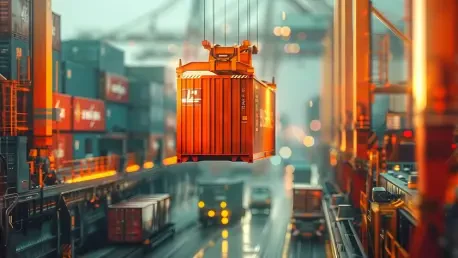Today, we’re thrilled to sit down with Rohit Laila, a seasoned veteran in the logistics industry with decades of experience spanning supply chain management and delivery. Rohit’s deep expertise and passion for technology and innovation in the sector make him the perfect guide to help us navigate the complex world of global container shipping. In this conversation, we’ll explore the turbulent state of the market, the dynamics behind the latest rankings of the top ocean carriers, the looming challenge of overcapacity, and what the future might hold for this critical industry.
How would you describe the current state of the global container shipping market, given all the ups and downs with tariffs and shifting peak seasons?
The market right now is incredibly unpredictable. Tariffs are changing almost by the day, and peak season timing isn’t following the usual patterns. This volatility creates a ripple effect across the entire supply chain. Shippers and logistics managers are struggling to plan ahead because they can’t predict costs or demand with any certainty. It’s a bit like trying to navigate a ship through a storm—you’ve got to be ready to adjust course at a moment’s notice.
What are some of the biggest challenges logistics managers are facing due to this uncertainty?
Logistics managers are really feeling the heat. One major issue is the inability to lock in reliable schedules or pricing. With tariffs fluctuating, they’re often caught between higher costs and the need to keep goods moving. There’s also the added pressure of rerouting shipments when trade policies shift unexpectedly. On top of that, customer expectations for fast delivery haven’t slowed down, so they’re juggling operational chaos while trying to maintain service levels.
Can you walk us through how tariff changes are reshaping peak-season planning for shippers?
Absolutely. Tariff changes throw a wrench into peak-season planning because they directly impact costs and trade lanes. Shippers typically plan months in advance for high-demand periods like the holiday season, but sudden tariff hikes or new trade barriers can force them to rethink everything. They might have to shift to different ports, source from alternative regions, or even delay shipments, which can lead to inventory shortages or higher storage costs. It’s a constant balancing act.
How are freight rates being influenced by all this turbulence in the industry?
Freight rates are all over the place right now. When tariffs or geopolitical issues disrupt major trade routes, you see supply and demand imbalances that drive rates up or down almost overnight. For instance, if a key route like U.S.-China gets hit with new restrictions, carriers might lower rates on less affected routes to fill capacity, or spike rates where demand suddenly surges. It’s a reactive cycle, and shippers are often left scrambling to adjust budgets.
How do you see geopolitical shifts and evolving trade policies affecting global trade patterns?
Geopolitical shifts are fundamentally altering trade flows. Take China’s diversification strategies, for example—they’re actively reducing reliance on certain markets like the U.S. by pushing trade toward other regions. This means new routes are emerging, and traditional hubs are seeing less volume. Add in trade policies like tariffs or sanctions, and you’ve got a landscape where carriers and shippers must be incredibly agile. Long-term, we’re likely to see a more fragmented global trade network with less predictability.
Looking at the latest rankings of ocean carriers, MSC is at the top with a massive fleet capacity. What do you think has fueled their dominance?
MSC’s position at the top, with over 6.7 million TEU, comes down to strategic growth and adaptability. They’ve invested heavily in expanding their fleet and optimizing their network to cover key trade lanes. Their focus on efficiency—whether through larger vessels or smarter routing—has allowed them to handle huge volumes while keeping costs competitive. Plus, they’ve been quick to capitalize on market shifts, which gives them an edge over others.
Maersk and CMA CGM are right behind MSC. How do their approaches differ, and what keeps them in the game?
Maersk and CMA CGM are powerhouses in their own right, but their strategies aren’t identical to MSC’s. Maersk has leaned into end-to-end logistics, positioning itself as more than just a carrier by offering integrated supply chain solutions. CMA CGM, on the other hand, has focused on strategic acquisitions and partnerships to bolster its global reach. Both stay competitive by modernizing fleets and embracing digital tools to improve transparency and efficiency for customers.
Smaller carriers like X-Press Feeders and SITC hold a tiny fraction of the market. What role do they play compared to the giants?
Smaller carriers often fill niche roles that the big players don’t prioritize. Companies like X-Press Feeders and SITC focus on regional or feeder services, connecting smaller ports to major hubs. They’re essential for moving cargo in areas where giants like MSC or Maersk don’t operate directly. Their smaller scale allows them to be more flexible, catering to specific markets or specialized cargo needs that don’t make sense for larger fleets.
Some carriers, like HMM and ZIM, have climbed the ranks in recent years. What’s driving their growth?
HMM and ZIM have seen impressive growth by seizing opportunities in a volatile market. HMM, for instance, has benefited from strategic fleet expansion and strong government backing in South Korea, allowing it to scale up capacity. ZIM has carved out a space by focusing on high-demand routes and leveraging digital innovation to attract customers. Both have been agile in responding to disruptions, which has helped them gain ground against more established names.
Were there any surprises in the Top 30 list for 2025, either with new entrants or shifts in rankings?
Honestly, the list is mostly what I’d expect, with the usual heavyweights dominating. However, seeing some smaller or regional carriers hold their ground or even inch up is noteworthy. It shows that specialization can still carve out a space in this competitive field. On the flip side, a few mid-tier carriers slipping in rank caught my eye—it’s a sign that failing to adapt to market shifts or invest in capacity can cost you quickly.
Analysts are pointing to a huge ship orderbook of 10 million TEU. How worried are you about overcapacity becoming a major issue?
I’m quite concerned, to be frank. An orderbook of 10 million TEU, with 7 million slated for delivery in just the next three years, is a massive overhang. If demand doesn’t keep pace with this influx of capacity, we’re looking at a flooded market. Overcapacity historically leads to price wars and squeezed margins, and with orders already locked in through 2030, carriers might be stuck with more ships than they can profitably deploy.
What kind of impact could this overcapacity have on freight rates and carrier profitability?
Overcapacity almost always drags freight rates down because carriers start competing aggressively to fill their ships. You end up with a race to the bottom on pricing, which directly hits profitability. For carriers, especially those with high debt from new ship orders, this could mean operating at a loss just to keep vessels moving. It’s a tough spot, and without careful planning, some might not weather the storm.
With new ships ordered for delivery as far out as 2030, how are carriers planning to manage supply and demand in the long run?
Carriers are looking at a few strategies to balance things out. Some are slowing down deliveries or renegotiating orders where possible. Others are focusing on diversifying services—think value-added logistics or niche routes—to create demand for their capacity. There’s also a push toward sustainability, with newer ships designed to be more fuel-efficient, which could help justify the added capacity if regulations tighten. But it’s a gamble, and not everyone will get it right.
What can carriers do to protect themselves from financial losses if overcapacity gets worse?
Carriers need to get creative to avoid taking a hit. One approach is forming alliances or sharing vessel space to optimize capacity without overspending. Cutting operational costs wherever possible—through automation or better fuel management—is another key move. Some might also look at scrapping older, less efficient ships to trim excess capacity. Ultimately, it’s about staying lean and focusing on markets or services where they can maintain pricing power.
What’s your forecast for the container shipping industry over the next few years, given these challenges?
I think we’re in for a bumpy ride over the next few years. Overcapacity is likely to pressure rates and profitability, especially for carriers that don’t adapt quickly. At the same time, geopolitical tensions and trade policy shifts will keep the market unpredictable. However, I’m optimistic about the role of technology—digital tools and data analytics could help carriers and shippers navigate these challenges more effectively. Those who innovate and stay flexible will come out ahead, but it won’t be an easy road.









